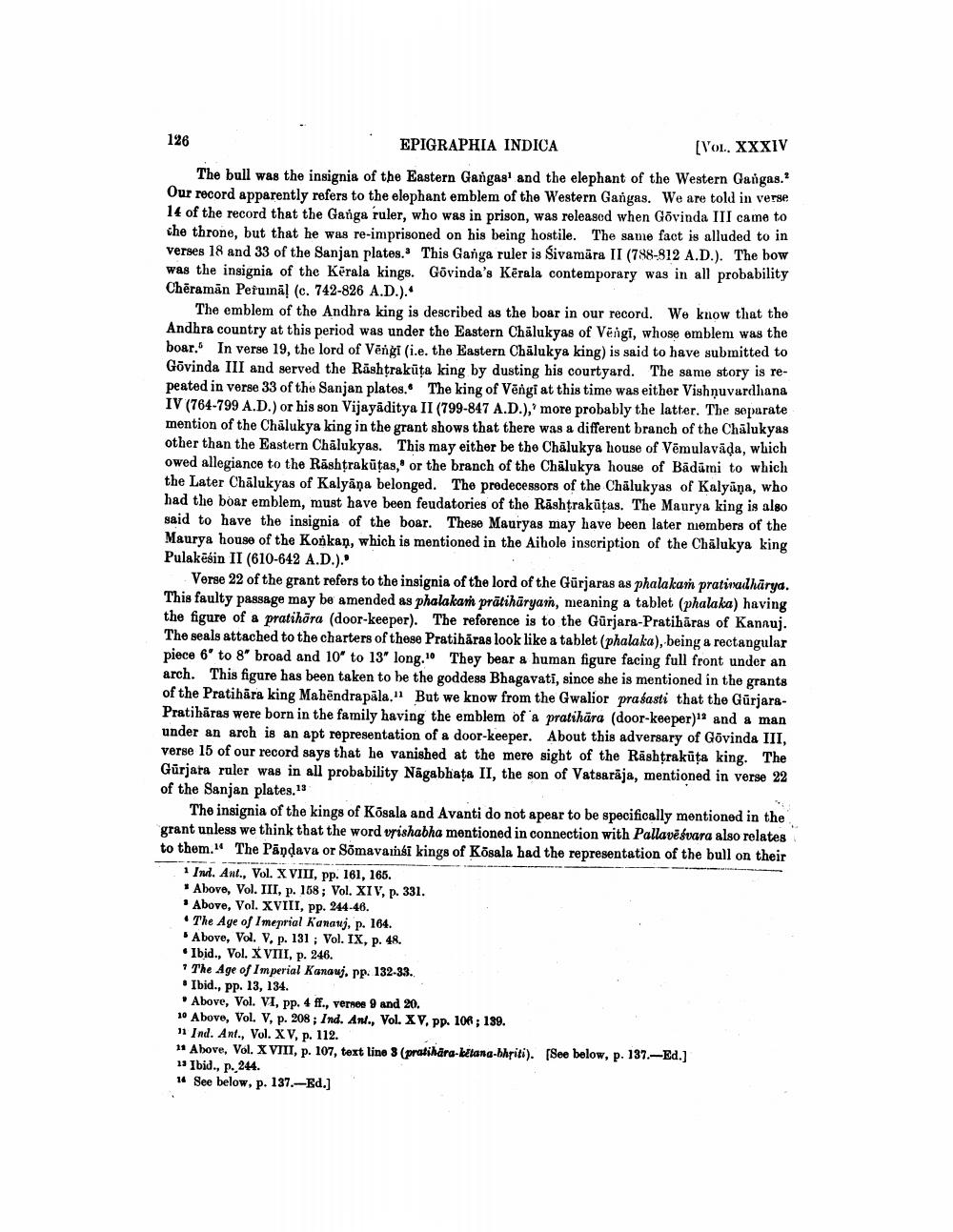________________
126
EPIGRAPHIA INDICA
[Vol. XXXIV
The bull was the insignia of the Eastern Gangas' and the elephant of the Western Gangas." Our record apparently refers to the elephant emblem of the Western Gangas. We are told in verse 14 of the record that the Ganga ruler, who was in prison, was released when Govinda III came to che throne, but that he was re-imprisoned on his being hostile. The same fact is alluded to in verses 18 and 33 of the Sanjan plates. This Ganga ruler is Sivamära II (788-812 A.D.). The bow was the insignia of the Kerala kings. Govinda's Kerala contemporary was in all probability Chēramān Petumā! (c. 742-826 A.D.).
The emblem of the Andhra king is described as the boar in our record. We know that the Andhra country at this period was under the Eastern Chalukyas of Vengi, whose emblem was the boar. In verse 19, the lord of Vēngi (i.e. the Eastern Chalukya king) is said to have submitted to Govinda III and served the Rashtrakūta king by dusting his courtyard. The same story is repeated in verse 33 of the Sanjan plates. The king of Vēngi at this time was either Vishnuvardhana IV (764-799 A.D.) or his son Vijayāditya II (799-847 A.D.),' more probably the latter. The separate mention of the Chalukya king in the grant shows that there was a different branch of the Chālukyas other than the Eastern Chalukyas. This may either be the Chalukya house of Vēmulavāda, which owed allegiance to the Rashtrakūtas, or the branch of the Chälukya house of Bädūmi to which the Later Chalukyas of Kalyana belonged. The predecessors of the Chalukyas of Kalyāņa, who had the boar emblem, must have been feudatories of the Rashtrakūtas. The Maurya king is also said to have the insignia of the boar. These Mauryas may have been later niombers of the Maurya house of the Konkan, which is mentioned in the Aihole inscription of the Chālukya king Pulakësin II (610-642 A.D.).
Verse 22 of the grant refers to the insignia of the lord of the Gurjaras as phalakam pratinadharya. This faulty passage may be amended as phalakaṁ prätihāryam, meaning a tablet (phalaka) having the figure of a pratihāra (door-keeper). The reference is to the Gürjara-Pratihāras of Kannuj. The seals attached to the charters of these Pratihāras look like a tablet (phalaka), being a rectangular piece 6 to 8' broad and 10' to 13' long. They bear a human figure facing full front under an arch. This figure has been taken to be the goddess Bhagavati, since she is mentioned in the grants of the Pratihära king Mahëndrapala." But we know from the Gwalior prasasti that the GurjaraPratihāras were born in the family having the emblem of a pratihära (door-keeper)" and a man under an arch is an apt representation of a door-keeper. About this adversary of Govinda III, Verse 15 of our record says that he vanished at the mere sight of the Rashtrakūta king. The Gürjara ruler was in all probability Nagabhata II, the son of Vatsarāja, mentioned in verse 22 of the Sanjan plates.13
The insignia of the kings of Kösala and Avanti do not apear to be specifically mentioned in the grant unless we think that the word vrishabha mentioned in connection with Pallavēšvara also relates to them. The Pandava or Somavamsi kings of Kösala had the representation of the bull on their
1 Ind. Ant., Vol. XVIII, pp. 161, 165. *Above, Vol. III, p. 158; Vol. XIV, p. 331. *Above, Vol. XVIII, pp. 244-46. • The Age of Imeprial Kananj, p. 164.
Above, Vol. V. p. 131 ; Vol. IX, p. 48. • Ibid., Vol. X VIII, p. 246.
The Age of Imperial Kanauj. pp. 132-33. . Ibid., pp. 13, 134.
Above, Vol. VI, pp. 4 ff., vernee 9 and 20. 10 Above, Vol. V, p. 208 ; Ind. Ant., Vol. XV. pp. 10R; 139. 11 Ind. Ant., Vol. XV, p. 112. 11 Above, Vol. XVIII, p. 107, text line 3 (pratihära-kitang-bhriti). (See below, p. 137.-Ed.] 11 Ibid., p. 244. 16 See below, p. 137.-Ed.)




